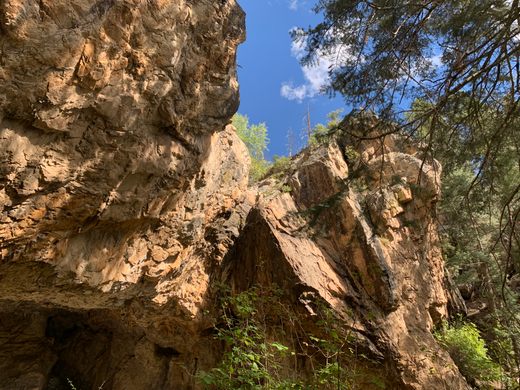AO Edited
El Salto del Agua Waterfall
A waterfall and cave near Arroyo Seco that inspired the writings of D. H. Lawrence, Willa Cather, and Mabel Dodge Luhan.
El Salto del Agua (the jumping water) waterfall and the large cave behind it near Arroyo Seco, New Mexico have an esteemed literary legacy. It inspired D. H. Lawrence’s 1924 short story “The Woman Who Rode Away,” and it was also the model for the Stone Lips cave in Willa Cather’s novel Death Comes for the Archbishop, published in 1927. During the summer months, the waterfall may dwindle to a trickle, but with the summer monsoons it can burst forth. During winter the waterfall forms an ice wall.
Willa Cather and her partner Edith Lewis visited the cave on July 10, 1925, as Edith wrote in her Blue Jay notebook: “Rode on horseback to Glorietta [a grove above Taos Pueblo] with Miss Foote. Rode in car to Ceremonial Cave. Car fell into ditch above Arroyo Seco.” The person who drove them to the “ceremonial cave” was Tony Lujan, Mabel Dodge Luhan’s husband and a Taos Puebloan.
Mabel, who was the doyen of the Taos artistic community, noted that Tony protested taking her to the cave. “The cave had a bad name among these Indians who believed it was still used by witches, and that it had been used for terrible things in the faraway past before the memory of this tribe,” she wrote in Edge of Taos Desert.
Mabel described her first visit to the cave in 1918 in Winter in Taos: “Tony led the way in behind the water to the shadowy cave. The light came in green and subdued and we found a large, dry chamber of rock with a high, domed ceiling, and with the sides sloping upwards to meet it. He showed me where there were steps, apparently roughly hewn out at the back wall, leading up to a ledge; and above the ledge and far above us, impossible to reach without a long ladder, there was the faint painting of a sun.”
“’Rising in the east,’ Tony said; and true enough, it was at the point where the sun comes over the mountains in the middle of winter.”
Mabel likewise wrote about taking D. H. Lawrence to the cave in 1922 in her book Lorenzo in Taos: “The vast, pelvic-shaped aperture faces the west and yawns upward to the sky; and over it descends the mountain water, falling thirty feet across the face of the entrance to form an icy pool below. We skirted the waterfall and entered the cavern; chill and damp and dark it was, too! Here there are holes hollowed out in the rock walls where Tony says the bears sleep in the winter; and at the right-hand side of the back wall of the place there are a number of rude climbing steps that lead up to a shelving ledge. Above this altar-like ledge there is a faint sun painted high up to the east of it. One by one we climbed to the high altar, and, looking before us, we saw the clear fall of water across the opening, green and transparent.”
Mabel called it “the ceremonial cave of long-forgotten days, where sacrifices were made behind the waterfall that veils its recessed altar.”
Know Before You Go
The El Salto del Agua cave and waterfall are on private property, the Martinez land grant, dating to the early 1700s. Visitors are welcome, but must pay the El Salto association's entrance fee and sign a liability waiver.
The cave and waterfall are easy to reach: from the parking lot, walk 0.1 miles to a fork in the trail. Take the right-hand trail and walk another 0.1 miles to the waterfall.
Note that there is another El Salto association trail about a mile to the south, a 4+ mile roundtrip into a beautiful forested canyon. There are no caves to be seen on that trail.




















Follow us on Twitter to get the latest on the world's hidden wonders.
Like us on Facebook to get the latest on the world's hidden wonders.
Follow us on Twitter Like us on Facebook